 Facebook
Facebook
 X
X
 Instagram
Instagram
 TikTok
TikTok
 Youtube
Youtube

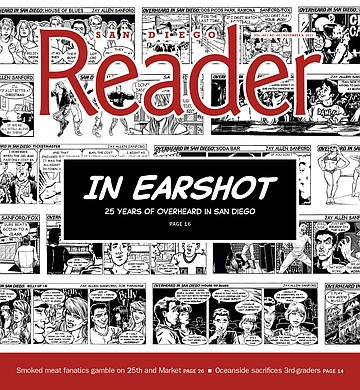
It usually surprises people to discover that my own artwork was never published in a single issue of Rock ‘N’ Roll Comics from 1989 through 1994. Nor did my drawings ever appear in any Carnal Comics between ‘94 and ‘99. This despite the fact that I ran the well-known first publishing company, and owned the lucrative second. Oh, I drew rough storyboards for my comic scripts to give to the actual illustrators. (The scripts were written as I drew the thumbnail sketches, so that I would always be thinking visually.) But my own artwork never appeared in a single one of the 300 or so comic books that I’ve written or published.
In fact, other than my high school newspaper and yearbook, I didn’t become a published cartoonist until I was 38 years old, in 1998 — two years after the Reader debuted Overheard in San Diego! And the only reason I started cartooning when I did was because the original Overheard artist vanished, and I realized that drawing it myself meant that I no longer had to split the paycheck.
At first, I was only the writer. I used artwork by Rock ‘N’ Roll Comics penman Scott Pentzer for the first Overheard, and then Hard Rock Comics artist Joe Paradise was aboard for around two years. When Paradise could no longer work on it, I was stuck with the unenviable task of either finding another artist or drawing the thing myself.
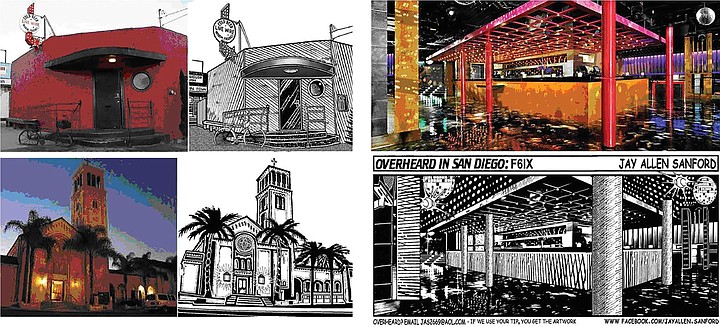
My crash course involved all but memorizing several highly recommended books on the art of comics, including/especially Understanding Comics by Scott McCloud and Comics & Sequential Art by Will Eisner. After studying those two industry bibles, and a series of How To Draw books by Tarzan artist Burne Hogarth, my first solo Overheard comic debuted in 1998.
My initial published cartoons were so awful that I secretly left them out of the Overheard in San Diego Omnibus book. And I would have gotten away with it, too, if someone hadn’t compared the book to the paper’s online archive, week by week, and complained! Well, I never said the book would have ALL the strips.
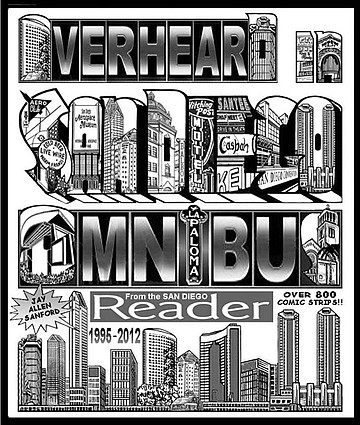
The pressure of a weekly deadline, coupled with my weak art skills, kept me chained to the drawing board over the next few months. I recycled a lot of Paradise’s backgrounds and setups, as I studied how to render art in a style similar to his. Once I finally got the hang of using a brush with a bit of flair, rather than the rapidograph technical pen that made my drawings look like woodcuts, the Overheard comics grew from barely competent to halfway decent to — I hope — not at all terrible. I somehow managed to make a good part of my living as a cartoonist for the next two decades.
Which is crazy, since that’s pretty much what I spent the first half of my creative career trying to avoid. I was a writer; I didn’t want to draw. I just wanted to tell real-life stories. After all, reality is stranger — and usually funnier — than fiction.
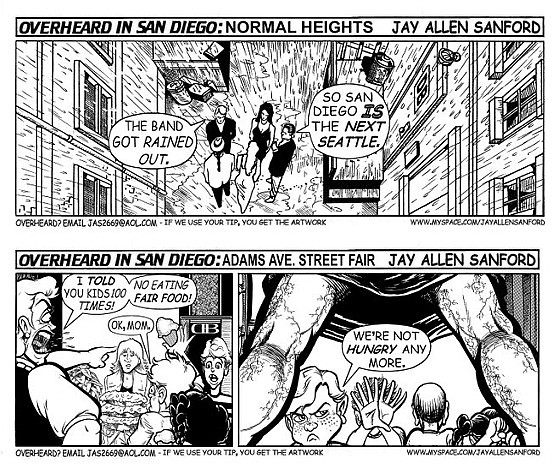
When I first landed in San Diego in the late ‘70s, I tried (and failed) to earn my first California cash by drawing bootleg caricatures in Balboa Park. I say “bootleg,” because I didn’t have the required permit, which means I couldn’t just set up an easel along the Prado. Instead, I had to sneak around with a huge sketchbook that I held up, so people could see the “Get Yourself Cartooned” drawing I had rigged up on the back of the pad.
Keep in mind that my only cartooning experience up until then was drawing gag illos for my high school newspaper and yearbook. But I was having trouble finding a job (mainly because I refused to cut my hair), and — at only ten bucks a pop — it was hard to make a living off donating blood plasma.
I walked around the Park and literally accosted tourists, asking if they wanted their caricature drawn. I had several carefully prepared samples in the sketchpad of celebs alongside their photos. I failed to tell anyone that each drawing probably took me at least two hours and one eraser to complete. Of course, nobody was gonna sit there for two hours while I sketched away.

I still feel so humiliated by the experience that I can’t bring myself to share specifics. All I’ll say is that I drew at least two dozen portraits over the course of two days. All but two of them remain in that cursed sketchbook. My would-be customers refused to pay for them. Hopefully, my skills have improved at least moderately.
Selling the Reader on running Overheard was surprisingly easy. I was already freelancing as a music writer, and one week, the Blurt section was short a story and had space to fill. With no article leads, I instead mocked up a comic strip with a bit of dialogue I’d recently overheard on a bus, using artwork from a Rock n’ Roll Comics strip I’d done. The music editor liked the cartoon so much that he requested a weekly edition. I didn’t even change the fonts used in the original mockup, and over 1300 strips later, the format remains almost identical.
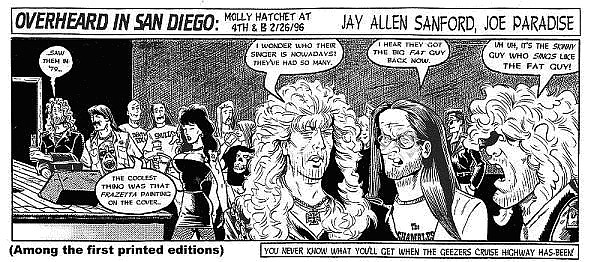
At first, all of the dialogue came from things I’d overheard myself, which wasn’t that difficult, since I was spending time in nightclubs and concert halls ever week, usually as part of my regular reporting duties. I’d write down the quotes and describe the speakers in a little notebook, or on a restaurant napkin or placemat. Then I’d give that to the artist, usually along with some photos of the locale.
Once I started drawing the thing myself, I invited others to send in overheard dialogue which I would then illustrate. The reward was that the tipster got to keep the original artboards. This “pay policy” has resulted in two things: multiple items from which to pick each week (even during the pandemic), and a dearth of archival material, since I’ve given most of it away. Some regular tipsters probably own more Jay Allen Sanford artwork than I do.
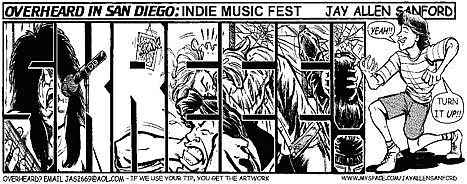
I’ve created a new Overheard comic every seven days now for 25 years, other than one week where the student cartoonists at Little Fish Studio (then in OB) won a contest to draw it (they got my paycheck too – hopefully the modest payoff didn’t scare them away from wanting a comic career). That includes several hospital stretches and an out-of-state relocation, as well as a year in the early 2000s when I was homeless, sometimes sleeping in a stairwell near the Reader’s Little Italy office so I could finish drawing the comic in their lobby on the morning it was due. Never missed one deadline, the whole time.
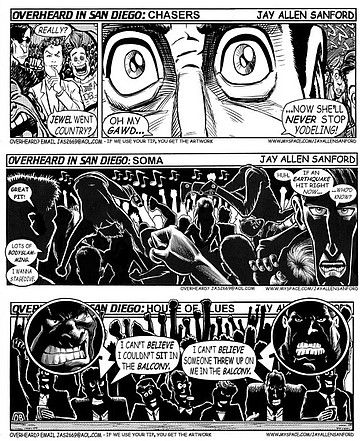
Now, there’s a giant archive of strips on the Reader site, an Overheard in San Diego theme song recorded by Cathryn Beeks and Sven-Erik Seaholm, and a sold-out book collection. I see the comic taped behind bars and on cash registers all over the city. I’ve landed dates with women who would never have focused their eyes on me if they hadn’t just found out that one of my comics was stuck under a magnet on their home refrigerator.
The first Overheard art show in Hillcrest circa 2010, with rarely photographed cartoonist Jay Allen Sanford on the right
There have been Overheard in San Diego art gallery showings, including a west coast tour that my mobile display embarked on without me, while I stayed home and drew more comic strips! The very first Overheard art show was at Hillcrest’s Ruby Room in 2010, and I just happened to be flipping the radio dial on the way there when I heard the Homegrown Hour playing the Overheard theme song on the air, which was as surreal as it was cool.
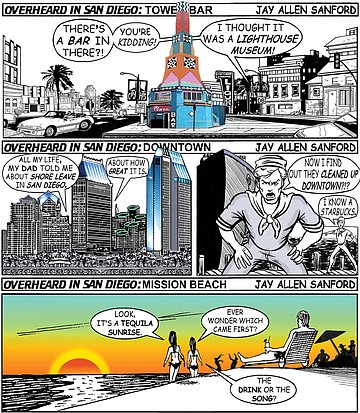
One thing people frequently ask is why Overheard has never “modernized” by going full color. After all, the rest of the paper went color years ago, and the Blurt slot occupied by the comic all these years has been running color photos since last century. Well, a trio of strips actually have run in color, but only because colors were indicated in the setup dialogue for those three.

How come? Easy: for most of my life, I was partially color blind, although I didn’t realize it. For years, I wasn’t even sure there was such a color as “orange,” because everything from dark yellow to red looked like the same shade to me. My girl sends me to the store to buy oranges? I’d bring home round lemons if it weren’t for signs. It wasn’t until I had a minor eye operation in the early 2000s that I could see a nearly full range of colors.
It’s hard to explain just how subjective “reality” is, until/unless your own reality entirely changes! Our perception of reality is at the mercy of how our eyeballs are shaped. And how they’re wired to our brain. Ask a bee or a fly to describe what they see, and you’ll hear stuff only Tim Leary has imagined. Just one component of what each of us calls reality depends on how our brain perceives things like color. Though I wasn’t diagnosed until I was an adult, I spent most of my life “suffering” from an ocular malformation that prevented me from seeing orange. Imagine what that was like as a kid at Halloween! Even my friends would tease me with “color tests.” “Hey Jay, what color is THAT?” And they’d snicker when I was apparently “wrong” (which was really more a matter of how differently my eyeballs translated the same stuff they saw).
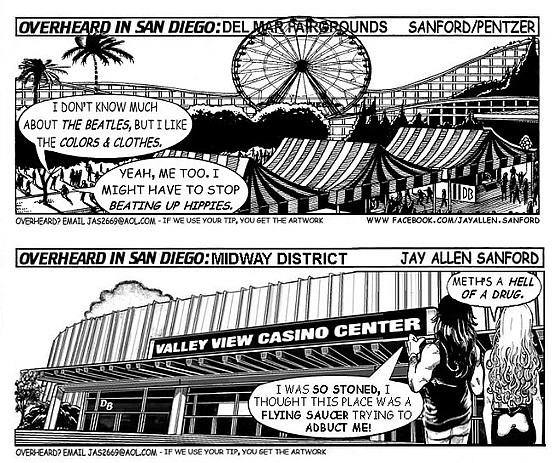
So I saw the world more or less in graduated sepia tones, something closer to monochromatic than psychedelic. That guy who did the Alien paintings, H.R. Giger, I think he had the same vision defect. And yet — I’ve colored comic books! And been paid to do so. See, I understood the full range of colors, thanks to RGB color scales we used to do color separations. I could tell you the exact mix of tones that equals orange. But I couldn’t see orange. I can remember, as a kid, thinking the whole world was playing a shitty prank on me with this orange crap.
(Side note: a very dimwitted young lady I dated once asked me “So when you get to a stop light, if you’re not sure what’s really red, how do you know to stop?” As if I can’t tell when the lights switch up from green. The same poor silly girl then asked – swear to gawd – as we pulled up to a stop sign, “So how did you know to stop?” Uh, ‘cause I can read?)

One final thought about color: the first time I did LSD, holy jeez: colors I didn’t know existed! Turns out they were there in my brain, after all. I just couldn’t get to them through my eyes. But from within, well, damn. I’d spend hours sitting in a car, just breathing fog onto the window and wiping my hand back and forth in the condensation, creating exploding rainbows with my fingertips. “Dude, trails!”
The only thing I’ve ever seen that comes close when I’m not on psychedelic drugs is LED-lit letters and numbers. That’s one odd thing that didn’t change even after they shaved my eyeballs into a near-normal shape: in the dark, the numbers on a digital alarm clock are, to me, still bright enough to land a plane by! I need to cover every LED light in my room with electrical tape, or I can’t sleep. Reality: it’s all in the eye of the beholder. And it all depends on what eyeballs you be holdin’!
I have made some concessions to the modern world: I now do Overheards with the assist of digital trickery, especially when it comes to rendering realistic background settings. Thanks to working from photos (gawd bless Photoshop), people no longer frown at my art and say “That doesn’t look anything like me” and walk off toward the Zoo or the carousel without paying me. I even post tutorials online showing step-by-step exactly how I transform photos into elements for Overheard comics.
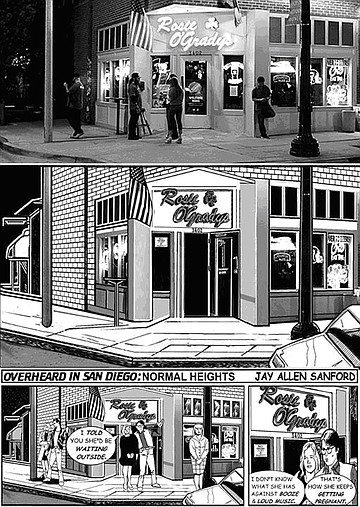
This practice once earned me an angry email from a well-known comic artist, blasting me for giving away secrets of photo manipulation that more and more illustrators are using. He likened my frequent online art lessons to Penn and Teller’s TV specials revealing the secrets behind magic tricks. I disagree. My point is to make it clear that, thanks to the tools available today, anybody can create something from nothing. Anyone with a song in their head can learn to play any instrument online, and then record and release a CD from home. A self-taught filmmaker can launch a Hollywood career with their PC and a YouTube URL.
And a talent-challenged comic fan like me can luck into a quarter century gig as a working weekly cartoonist.
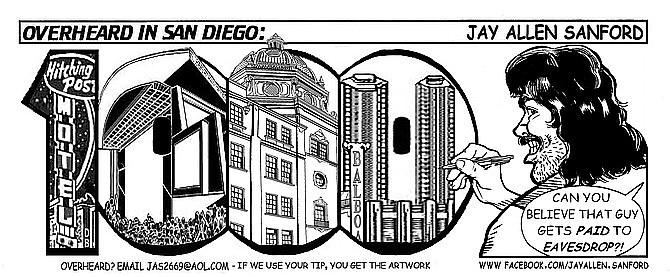
Creativity is, to my mind, the key to happiness, the most vital ingredient of a well-lived life. We are what we make. And what could possibly be more satisfying than creating something out of your own experience and imagination? An idea, an inspiration that you nourished and brought to glorious life. Anybody can learn to do what I do. That’s not a light to be hid under a bushel. Creativity is the light of the world. And that’s always worth sharing.



It usually surprises people to discover that my own artwork was never published in a single issue of Rock ‘N’ Roll Comics from 1989 through 1994. Nor did my drawings ever appear in any Carnal Comics between ‘94 and ‘99. This despite the fact that I ran the well-known first publishing company, and owned the lucrative second. Oh, I drew rough storyboards for my comic scripts to give to the actual illustrators. (The scripts were written as I drew the thumbnail sketches, so that I would always be thinking visually.) But my own artwork never appeared in a single one of the 300 or so comic books that I’ve written or published.
In fact, other than my high school newspaper and yearbook, I didn’t become a published cartoonist until I was 38 years old, in 1998 — two years after the Reader debuted Overheard in San Diego! And the only reason I started cartooning when I did was because the original Overheard artist vanished, and I realized that drawing it myself meant that I no longer had to split the paycheck.
At first, I was only the writer. I used artwork by Rock ‘N’ Roll Comics penman Scott Pentzer for the first Overheard, and then Hard Rock Comics artist Joe Paradise was aboard for around two years. When Paradise could no longer work on it, I was stuck with the unenviable task of either finding another artist or drawing the thing myself.

My crash course involved all but memorizing several highly recommended books on the art of comics, including/especially Understanding Comics by Scott McCloud and Comics & Sequential Art by Will Eisner. After studying those two industry bibles, and a series of How To Draw books by Tarzan artist Burne Hogarth, my first solo Overheard comic debuted in 1998.
My initial published cartoons were so awful that I secretly left them out of the Overheard in San Diego Omnibus book. And I would have gotten away with it, too, if someone hadn’t compared the book to the paper’s online archive, week by week, and complained! Well, I never said the book would have ALL the strips.

The pressure of a weekly deadline, coupled with my weak art skills, kept me chained to the drawing board over the next few months. I recycled a lot of Paradise’s backgrounds and setups, as I studied how to render art in a style similar to his. Once I finally got the hang of using a brush with a bit of flair, rather than the rapidograph technical pen that made my drawings look like woodcuts, the Overheard comics grew from barely competent to halfway decent to — I hope — not at all terrible. I somehow managed to make a good part of my living as a cartoonist for the next two decades.
Which is crazy, since that’s pretty much what I spent the first half of my creative career trying to avoid. I was a writer; I didn’t want to draw. I just wanted to tell real-life stories. After all, reality is stranger — and usually funnier — than fiction.

When I first landed in San Diego in the late ‘70s, I tried (and failed) to earn my first California cash by drawing bootleg caricatures in Balboa Park. I say “bootleg,” because I didn’t have the required permit, which means I couldn’t just set up an easel along the Prado. Instead, I had to sneak around with a huge sketchbook that I held up, so people could see the “Get Yourself Cartooned” drawing I had rigged up on the back of the pad.
Keep in mind that my only cartooning experience up until then was drawing gag illos for my high school newspaper and yearbook. But I was having trouble finding a job (mainly because I refused to cut my hair), and — at only ten bucks a pop — it was hard to make a living off donating blood plasma.
I walked around the Park and literally accosted tourists, asking if they wanted their caricature drawn. I had several carefully prepared samples in the sketchpad of celebs alongside their photos. I failed to tell anyone that each drawing probably took me at least two hours and one eraser to complete. Of course, nobody was gonna sit there for two hours while I sketched away.

I still feel so humiliated by the experience that I can’t bring myself to share specifics. All I’ll say is that I drew at least two dozen portraits over the course of two days. All but two of them remain in that cursed sketchbook. My would-be customers refused to pay for them. Hopefully, my skills have improved at least moderately.
Selling the Reader on running Overheard was surprisingly easy. I was already freelancing as a music writer, and one week, the Blurt section was short a story and had space to fill. With no article leads, I instead mocked up a comic strip with a bit of dialogue I’d recently overheard on a bus, using artwork from a Rock n’ Roll Comics strip I’d done. The music editor liked the cartoon so much that he requested a weekly edition. I didn’t even change the fonts used in the original mockup, and over 1300 strips later, the format remains almost identical.

At first, all of the dialogue came from things I’d overheard myself, which wasn’t that difficult, since I was spending time in nightclubs and concert halls ever week, usually as part of my regular reporting duties. I’d write down the quotes and describe the speakers in a little notebook, or on a restaurant napkin or placemat. Then I’d give that to the artist, usually along with some photos of the locale.
Once I started drawing the thing myself, I invited others to send in overheard dialogue which I would then illustrate. The reward was that the tipster got to keep the original artboards. This “pay policy” has resulted in two things: multiple items from which to pick each week (even during the pandemic), and a dearth of archival material, since I’ve given most of it away. Some regular tipsters probably own more Jay Allen Sanford artwork than I do.

I’ve created a new Overheard comic every seven days now for 25 years, other than one week where the student cartoonists at Little Fish Studio (then in OB) won a contest to draw it (they got my paycheck too – hopefully the modest payoff didn’t scare them away from wanting a comic career). That includes several hospital stretches and an out-of-state relocation, as well as a year in the early 2000s when I was homeless, sometimes sleeping in a stairwell near the Reader’s Little Italy office so I could finish drawing the comic in their lobby on the morning it was due. Never missed one deadline, the whole time.

Now, there’s a giant archive of strips on the Reader site, an Overheard in San Diego theme song recorded by Cathryn Beeks and Sven-Erik Seaholm, and a sold-out book collection. I see the comic taped behind bars and on cash registers all over the city. I’ve landed dates with women who would never have focused their eyes on me if they hadn’t just found out that one of my comics was stuck under a magnet on their home refrigerator.
The first Overheard art show in Hillcrest circa 2010, with rarely photographed cartoonist Jay Allen Sanford on the right
There have been Overheard in San Diego art gallery showings, including a west coast tour that my mobile display embarked on without me, while I stayed home and drew more comic strips! The very first Overheard art show was at Hillcrest’s Ruby Room in 2010, and I just happened to be flipping the radio dial on the way there when I heard the Homegrown Hour playing the Overheard theme song on the air, which was as surreal as it was cool.

One thing people frequently ask is why Overheard has never “modernized” by going full color. After all, the rest of the paper went color years ago, and the Blurt slot occupied by the comic all these years has been running color photos since last century. Well, a trio of strips actually have run in color, but only because colors were indicated in the setup dialogue for those three.

How come? Easy: for most of my life, I was partially color blind, although I didn’t realize it. For years, I wasn’t even sure there was such a color as “orange,” because everything from dark yellow to red looked like the same shade to me. My girl sends me to the store to buy oranges? I’d bring home round lemons if it weren’t for signs. It wasn’t until I had a minor eye operation in the early 2000s that I could see a nearly full range of colors.
It’s hard to explain just how subjective “reality” is, until/unless your own reality entirely changes! Our perception of reality is at the mercy of how our eyeballs are shaped. And how they’re wired to our brain. Ask a bee or a fly to describe what they see, and you’ll hear stuff only Tim Leary has imagined. Just one component of what each of us calls reality depends on how our brain perceives things like color. Though I wasn’t diagnosed until I was an adult, I spent most of my life “suffering” from an ocular malformation that prevented me from seeing orange. Imagine what that was like as a kid at Halloween! Even my friends would tease me with “color tests.” “Hey Jay, what color is THAT?” And they’d snicker when I was apparently “wrong” (which was really more a matter of how differently my eyeballs translated the same stuff they saw).

So I saw the world more or less in graduated sepia tones, something closer to monochromatic than psychedelic. That guy who did the Alien paintings, H.R. Giger, I think he had the same vision defect. And yet — I’ve colored comic books! And been paid to do so. See, I understood the full range of colors, thanks to RGB color scales we used to do color separations. I could tell you the exact mix of tones that equals orange. But I couldn’t see orange. I can remember, as a kid, thinking the whole world was playing a shitty prank on me with this orange crap.
(Side note: a very dimwitted young lady I dated once asked me “So when you get to a stop light, if you’re not sure what’s really red, how do you know to stop?” As if I can’t tell when the lights switch up from green. The same poor silly girl then asked – swear to gawd – as we pulled up to a stop sign, “So how did you know to stop?” Uh, ‘cause I can read?)

One final thought about color: the first time I did LSD, holy jeez: colors I didn’t know existed! Turns out they were there in my brain, after all. I just couldn’t get to them through my eyes. But from within, well, damn. I’d spend hours sitting in a car, just breathing fog onto the window and wiping my hand back and forth in the condensation, creating exploding rainbows with my fingertips. “Dude, trails!”
The only thing I’ve ever seen that comes close when I’m not on psychedelic drugs is LED-lit letters and numbers. That’s one odd thing that didn’t change even after they shaved my eyeballs into a near-normal shape: in the dark, the numbers on a digital alarm clock are, to me, still bright enough to land a plane by! I need to cover every LED light in my room with electrical tape, or I can’t sleep. Reality: it’s all in the eye of the beholder. And it all depends on what eyeballs you be holdin’!
I have made some concessions to the modern world: I now do Overheards with the assist of digital trickery, especially when it comes to rendering realistic background settings. Thanks to working from photos (gawd bless Photoshop), people no longer frown at my art and say “That doesn’t look anything like me” and walk off toward the Zoo or the carousel without paying me. I even post tutorials online showing step-by-step exactly how I transform photos into elements for Overheard comics.

This practice once earned me an angry email from a well-known comic artist, blasting me for giving away secrets of photo manipulation that more and more illustrators are using. He likened my frequent online art lessons to Penn and Teller’s TV specials revealing the secrets behind magic tricks. I disagree. My point is to make it clear that, thanks to the tools available today, anybody can create something from nothing. Anyone with a song in their head can learn to play any instrument online, and then record and release a CD from home. A self-taught filmmaker can launch a Hollywood career with their PC and a YouTube URL.
And a talent-challenged comic fan like me can luck into a quarter century gig as a working weekly cartoonist.

Creativity is, to my mind, the key to happiness, the most vital ingredient of a well-lived life. We are what we make. And what could possibly be more satisfying than creating something out of your own experience and imagination? An idea, an inspiration that you nourished and brought to glorious life. Anybody can learn to do what I do. That’s not a light to be hid under a bushel. Creativity is the light of the world. And that’s always worth sharing.
Comments